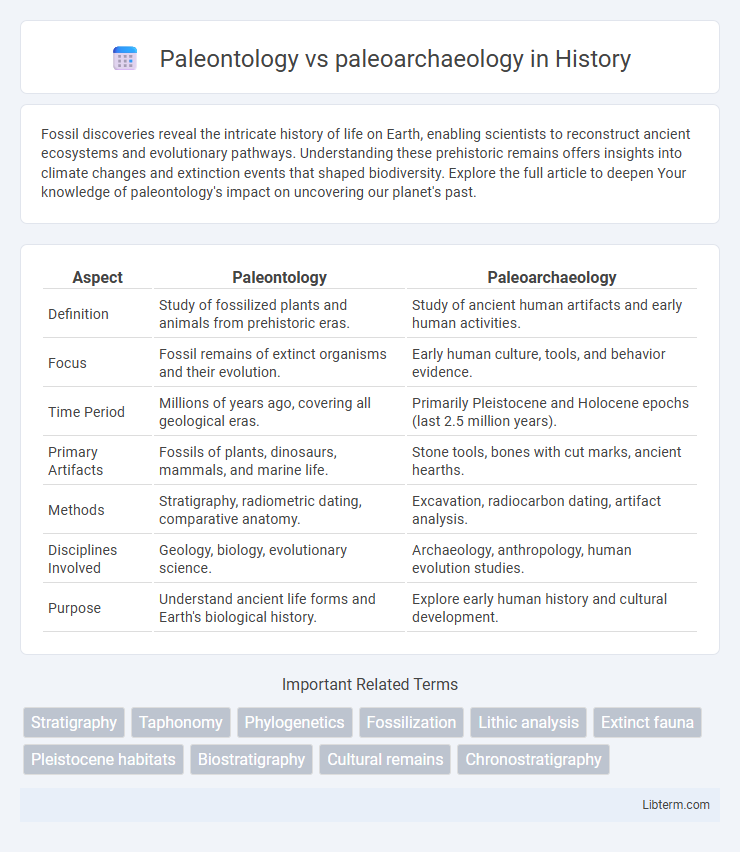Fossil discoveries reveal the intricate history of life on Earth, enabling scientists to reconstruct ancient ecosystems and evolutionary pathways. Understanding these prehistoric remains offers insights into climate changes and extinction events that shaped biodiversity. Explore the full article to deepen Your knowledge of paleontology's impact on uncovering our planet's past.
Table of Comparison
| Aspect | Paleontology | Paleoarchaeology |
|---|---|---|
| Definition | Study of fossilized plants and animals from prehistoric eras. | Study of ancient human artifacts and early human activities. |
| Focus | Fossil remains of extinct organisms and their evolution. | Early human culture, tools, and behavior evidence. |
| Time Period | Millions of years ago, covering all geological eras. | Primarily Pleistocene and Holocene epochs (last 2.5 million years). |
| Primary Artifacts | Fossils of plants, dinosaurs, mammals, and marine life. | Stone tools, bones with cut marks, ancient hearths. |
| Methods | Stratigraphy, radiometric dating, comparative anatomy. | Excavation, radiocarbon dating, artifact analysis. |
| Disciplines Involved | Geology, biology, evolutionary science. | Archaeology, anthropology, human evolution studies. |
| Purpose | Understand ancient life forms and Earth's biological history. | Explore early human history and cultural development. |
Introduction to Paleontology and Paleoarchaeology
Paleontology studies ancient life through fossils, focusing on organisms' evolution and environments over millions of years. Paleoarchaeology combines archaeological methods with paleontological data to examine human prehistory and cultural development through both fossilized remains and artifacts. Both fields rely on stratigraphy and dating techniques to interpret the Earth's biological and cultural past.
Defining Paleontology: The Study of Ancient Life
Paleontology is the scientific study of ancient life through the examination of fossils, including plants, animals, and microorganisms, preserved in geological formations. This field utilizes stratigraphy and radiometric dating to reconstruct the evolutionary history and environmental contexts of extinct species. Unlike paleoarchaeology, which concentrates on human prehistory and cultural artifacts, paleontology provides insights into the broader biodiversity of past geological eras.
Understanding Paleoarchaeology: Exploring Early Human History
Paleoarchaeology focuses on uncovering early human history through the study of ancient artifacts, fossils, and environmental contexts, emphasizing the human past and cultural evolution. Unlike paleontology, which broadly examines prehistoric life including plants and animals, paleoarchaeology specifically investigates human ancestors and their behaviors, tools, and habitats. This discipline integrates archaeological methods with paleoenvironmental data to reconstruct early human societies and their adaptation over time.
Core Objectives: What Each Discipline Seeks to Uncover
Paleontology focuses on uncovering the history of life on Earth through the study of fossils, emphasizing evolutionary patterns, ancient ecosystems, and extinct species. Paleoarchaeology investigates human prehistory by analyzing fossilized remains and artifacts to understand early human behavior, culture, and adaptation. Both disciplines seek to reconstruct past environments but differ in their core objectives: paleontology targets broader biological history, while paleoarchaeology centers on early human history and cultural development.
Key Methods and Techniques in Paleontology
Paleontology primarily employs fossil excavation, stratigraphic analysis, and radiometric dating to study ancient life forms and their evolutionary history. Techniques such as CT scanning and isotopic analysis allow for detailed examination of fossil morphology and paleoenvironmental conditions. These methods distinguish paleontology from paleoarchaeology, which focuses more on human artifacts and cultural remains using typology and excavation.
Essential Tools and Practices in Paleoarchaeology
Paleoarchaeology employs essential tools such as trowels, brushes, and sieves to carefully excavate and analyze artifacts within stratified layers, ensuring precise contextual understanding of human history. Radiocarbon dating and GIS mapping are integral practices used to establish chronological frameworks and spatial relationships at archaeological sites. This discipline combines meticulous fieldwork with laboratory analysis to reconstruct ancient human behaviors and environmental interactions.
Types of Discoveries: Fossils vs. Artifacts
Paleontology centers on the discovery and study of fossils, including bones, teeth, and imprints of ancient plants and animals, providing insights into prehistoric life and evolutionary processes. Paleoarchaeology, on the other hand, focuses on artifacts such as tools, pottery, and other cultural remains created by early humans, shedding light on human behavior and societal development. Fossils reveal biological and ecological data, while artifacts offer evidence of technological advances and cultural practices.
Famous Case Studies in Both Fields
The La Brea Tar Pits in Los Angeles represent a famous paleontological case study, preserving thousands of Ice Age fossils like mammoths and saber-toothed cats that reveal prehistoric ecosystems. In contrast, the discovery of Otzi the Iceman, a well-preserved mummy found in the Alps, serves as a landmark paleoarchaeological case, providing insights into Copper Age human life, tools, and clothing. Both fields utilize fossil and artifact analysis to reconstruct ancient environments and human history, but paleontology emphasizes extinct organisms, while paleoarchaeology focuses on ancient human cultures.
Overlapping Areas and Interdisciplinary Research
Paleontology and paleoarchaeology both study ancient life and human history through fossil and artifact analysis, with overlapping areas including the examination of prehistoric environments and evolutionary patterns. Interdisciplinary research often combines paleontological methods, such as fossil identification and stratigraphy, with archaeological techniques like excavation and cultural context interpretation to reconstruct past ecosystems and human behaviors. Collaborative studies enhance understanding of early hominins' interactions with their habitats, bridging biological evolution and cultural development.
The Future of Paleontology and Paleoarchaeology
The future of paleontology involves advanced technologies such as AI and 3D imaging to enhance fossil analysis and accelerate discoveries, expanding understanding of prehistoric life. Paleoarchaeology is increasingly integrating multidisciplinary approaches, combining genetic data, paleoenvironmental studies, and archaeological context to reconstruct ancient human behavior more accurately. Both fields are embracing digital databases and global collaborations, driving innovations in preserving and interpreting the fossil and artifact records.
Paleontology Infographic

 libterm.com
libterm.com